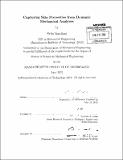| dc.contributor.advisor | Lynette A. Jones. | en_US |
| dc.contributor.author | Sandford, Erika J. (Erika Jaye) | en_US |
| dc.contributor.other | Massachusetts Institute of Technology. Dept. of Mechanical Engineering. | en_US |
| dc.date.accessioned | 2012-11-19T19:20:22Z | |
| dc.date.available | 2012-11-19T19:20:22Z | |
| dc.date.copyright | 2012 | en_US |
| dc.date.issued | 2012 | en_US |
| dc.identifier.uri | http://hdl.handle.net/1721.1/74941 | |
| dc.description | Thesis (S.M.)--Massachusetts Institute of Technology, Dept. of Mechanical Engineering, 2012. | en_US |
| dc.description | Cataloged from PDF version of thesis. | en_US |
| dc.description | Includes bibliographical references (p. 76-79). | en_US |
| dc.description.abstract | Existing skin mechanical testing devices focus on measuring skin elasticity and are not tailored to assess the dynamic behavior of skin. The mathematical techniques used to analyze data collected using these devices are often not optimal. A new dynamic mechanical device that measures the linear dynamics of skin was developed and tested. The mechanical properties of skin were evaluated in experiments in which the stiffness and damping parameter were measured at different locations on the arm and hand, when stratum corneum hydration was varied by controlled changes in environmental humidity, and following the application of film-forming polymers. Parallel measurements were made with the Cutometer® so that the two devices could be compared. The findings revealed that reliable and valid measurements of skin mechanical properties can be obtained from the device. The stiffness of the skin was shown to vary significantly as a function of skin site, changes in stratum corneum hydration, and following the application of the polymer films. Changes in the damping parameter were less consistently associated with varying the condition of the skin. The high reliability and speed of measurement make this device and analytic procedure an attractive option for testing skin mechanics. | en_US |
| dc.description.statementofresponsibility | by Erika Sandford. | en_US |
| dc.format.extent | 84 p. | en_US |
| dc.language.iso | eng | en_US |
| dc.publisher | Massachusetts Institute of Technology | en_US |
| dc.rights | M.I.T. theses are protected by
copyright. They may be viewed from this source for any purpose, but
reproduction or distribution in any format is prohibited without written
permission. See provided URL for inquiries about permission. | en_US |
| dc.rights.uri | http://dspace.mit.edu/handle/1721.1/7582 | en_US |
| dc.subject | Mechanical Engineering. | en_US |
| dc.title | Capturing skin properties from dynamic mechanical analyses | en_US |
| dc.type | Thesis | en_US |
| dc.description.degree | S.M. | en_US |
| dc.contributor.department | Massachusetts Institute of Technology. Department of Mechanical Engineering | |
| dc.identifier.oclc | 815966516 | en_US |
